Understanding the Importance of Rug Size in a Living Room
Rug size significantly impacts a living room’s aesthetic, defining spaces and maintaining proportions. It harmonizes furniture, directs traffic, and enhances comfort, making it a crucial element in interior design.
1.1 How Rug Size Affects the Aesthetic of the Room
Rug size plays a pivotal role in shaping the aesthetic of a living room. A well-chosen rug can enhance harmony, balance, and visual flow, while an ill-fitting size may disrupt the room’s cohesion. The right size anchors furniture, creating a sense of unity and defining the space. Too small, and the room feels fragmented; too large, and it overwhelms. Rug size also influences proportions, ensuring furniture appears balanced. For instance, an 8×10 or 9×12 rug is ideal for medium to large rooms, while smaller rugs suit cozy spaces. Using tape to outline the rug’s dimensions helps visualize its impact, ensuring it complements the room’s design and material choices effectively.
1.2 The Role of Rug Size in Defining Space
Rug size is instrumental in defining space within a living room, creating distinct zones and enhancing functionality. A rug acts as a visual anchor, separating seating areas from walkways and emphasizing specific design elements. Properly sizing ensures furniture placement feels intentional, with all legs on the rug for cohesion or only front legs for a smaller, intimate setup. Additionally, rug size influences traffic flow, guiding movement smoothly through the room. Using tape to mark potential rug dimensions helps visualize how it will define the space before making a purchase. This step ensures the rug complements the room’s layout and proportions, creating a balanced and inviting atmosphere.
1.3 Rug Size and Its Impact on Room Proportions
Rug size plays a critical role in maintaining room proportions, ensuring balance and harmony. A rug that is too small can make a room feel disjointed, while one that is too large may overwhelm the space. The right size creates a sense of cohesion, tying together furniture and decor. Properly scaled rugs enhance the room’s dimensions, making small spaces feel larger or cozy, depending on the design. Measure carefully to ensure the rug complements the room’s proportions, avoiding extremes that disrupt the visual flow. A well-chosen rug size ensures the space feels balanced, harmonious, and aesthetically pleasing.
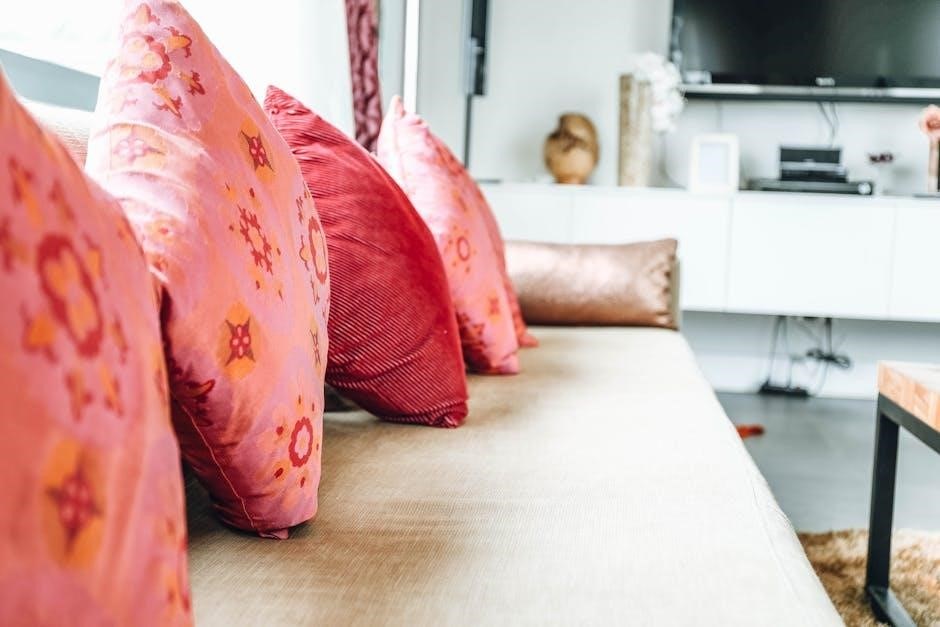
Measuring Your Living Room for the Perfect Rug
Accurately measure your room’s dimensions, noting furniture placement and traffic flow. Use tape to visualize rug size and ensure proper fit for a balanced, functional space.
2.1 How to Measure the Room Dimensions
To measure your living room, start by recording the length and width using a tape measure. Note the placement of doors, windows, and any built-in features. Consider the shape of the room—whether it’s rectangular, square, or irregular. For irregular shapes, break the room into smaller sections and measure each area separately. This ensures you have an accurate understanding of the space where the rug will be placed. Always measure twice to avoid errors and compare your measurements with standard rug sizes to find the best fit for your layout and furniture arrangement.
2.2 Measuring Furniture to Determine Rug Size
Measuring your furniture is crucial for selecting the right rug size. Start by recording the dimensions of your sofa, coffee table, and chairs. Ensure the rug extends beyond the furniture edges to create a balanced look. For a sectional sofa, measure its length and width to choose a rug that fits comfortably underneath. If placing the rug under a coffee table, consider the table’s size and leave enough space around it. Measure the distance between furniture legs to ensure the rug fits neatly beneath. This step helps in selecting a rug that complements your furniture arrangement and enhances the room’s harmony.
2.3 Using Tape to Visualize Rug Placement
Using tape to visualize rug placement is a practical approach to ensure the right fit. Place masking or painter’s tape on the floor to outline the rug’s dimensions. This method helps you see how the rug will look in the space. Adjust the tape as needed to experiment with different sizes and shapes. It’s especially useful for understanding how the rug will interact with furniture and traffic flow. By visualizing the rug’s position, you can make informed decisions before making a purchase. This step ensures the rug complements the room’s layout and meets your aesthetic goals effectively.
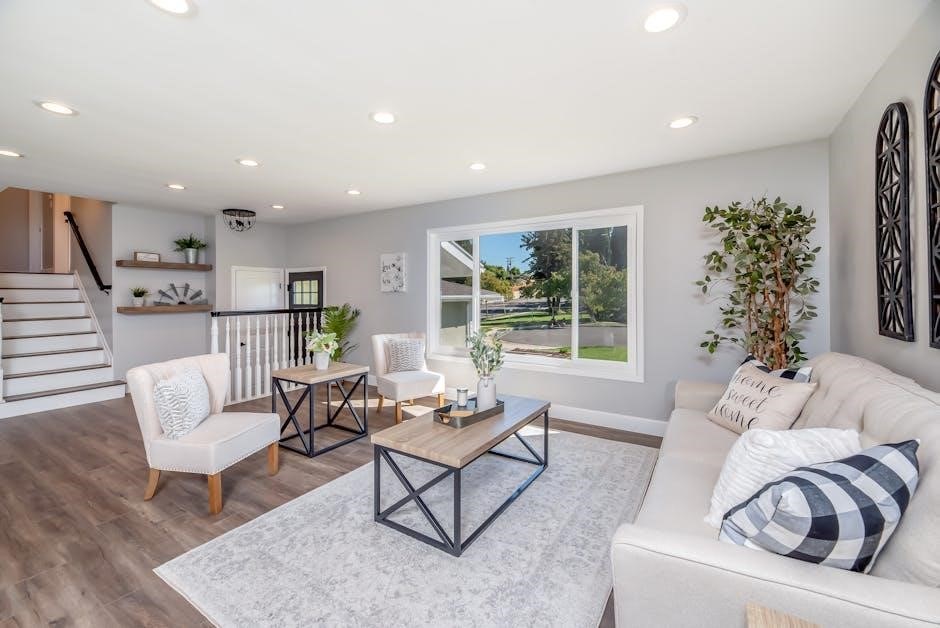
Standard Rug Sizes for Living Rooms
Standard rug sizes for living rooms typically range from 8×10 to 9×12 feet, with larger options available for spacious areas. These sizes complement furniture layouts effectively.
3.1 Common Rug Sizes and Their Uses
Common rug sizes like 8×10 and 9×12 feet are popular for living rooms, offering ample coverage for furniture. Smaller rugs (5×7 or 6×9 feet) suit cozy spaces, while larger rugs (12×15 feet) are ideal for expansive areas. Rectangular rugs are versatile, fitting most layouts, while square rugs add a modern touch. Round rugs complement circular furniture or create focal points. The choice depends on room dimensions, furniture arrangement, and desired aesthetic. Proper sizing ensures functionality and visual harmony, making the rug a central element in the room’s design.
3.2 8×10 vs. 9×12 Rugs: Which is Better?
The choice between 8×10 and 9×12 rugs depends on room size and furniture layout. An 8×10 rug fits medium-sized rooms, accommodating sofas and coffee tables neatly. It’s ideal for spaces where the rug needs to anchor the seating area without overwhelming the room. A 9×12 rug is better for larger rooms or open layouts, providing a spacious feel and covering more floor area. Measure the room and furniture to decide. Both sizes are versatile, but the 9×12 offers a grander appearance, while the 8×10 is cozy and practical. Choose based on the room’s dimensions and desired ambiance.
3.3 When to Choose Larger or Smaller Rugs
Choosing between larger or smaller rugs depends on the room’s size, furniture layout, and desired aesthetic. Larger rugs, like 9×12, suit spacious rooms, creating a cohesive look and anchoring furniture. They’re ideal for open layouts or rooms with oversized sofas. Smaller rugs, such as 6×9, are better for cozy, compact spaces or to define smaller seating areas within a larger room. Consider traffic flow; larger rugs handle foot traffic better, while smaller rugs add warmth without overwhelming the space. Balance proportions to avoid a rug that’s too dominant or too insignificant. Measure carefully to ensure the rug complements the room’s dimensions and furniture arrangement for harmony and functionality.
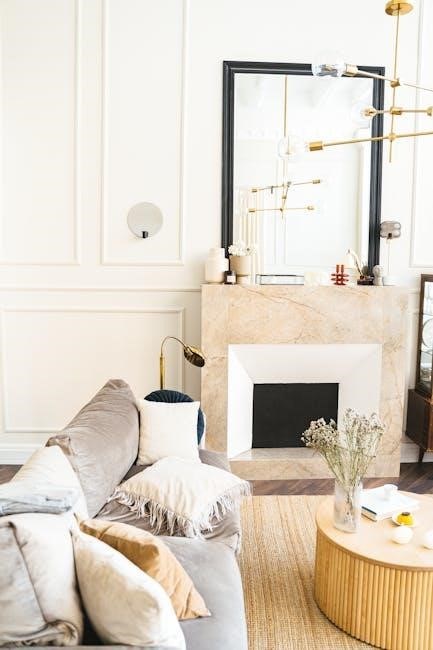
Placement Strategies for Living Room Rugs
Strategic rug placement enhances room layout, defining seating areas and directing traffic. Position rugs under furniture like sofas or coffee tables to create a cohesive, inviting atmosphere.
4.1 Placing the Rug Under the Sofa
Placing a rug under the sofa is a popular choice to anchor the seating area. Ensure the rug extends at least 12 inches on all sides of the sofa for a balanced look. This creates a cohesive space and prevents the rug from appearing too small. For sectional sofas, choose a rug large enough to fit under the entire unit or at least the front edges. This placement helps define the seating zone and adds warmth underfoot. It also protects the floor from furniture legs and creates a harmonious flow in the room. Proper alignment ensures comfort and visual appeal.
4.2 Rugs Under Coffee Tables and Chairs
A rug under a coffee table and chairs adds warmth and defines the seating area. Choose a rug large enough to extend 12-18 inches beyond the table on all sides. This ensures the chairs can move without catching the rug edges. For a standard setup, a 9×12 rug often works well. Place the rug so it aligns with the seating arrangement, ensuring all chair legs remain on the rug, even when pulled out. This prevents scratching the floor and ensures stability. The rug should complement the room’s proportions and furniture layout, creating a inviting atmosphere for relaxation and conversation. Proper placement enhances both functionality and aesthetics.
4.3 Positioning Rugs in Oddly Shaped Rooms
Positioning rugs in oddly shaped rooms requires careful planning to maintain balance and harmony. Start by identifying the room’s focal point, such as a fireplace or seating area, and center the rug around it. For asymmetrical spaces, consider placing the rug in a way that creates symmetry or defines zones within the room. Use tape to visualize the rug’s placement before committing. Ensure the rug extends beyond furniture edges to avoid a cramped look. In angular or curved spaces, a round or smaller rug can soften sharp corners. The goal is to create a cohesive layout that enhances the room’s unique features while ensuring functionality and visual appeal. Proper positioning transforms challenging spaces into inviting areas.
Choosing the Right Rug Size Based on Furniture Layout
Measure furniture dimensions to ensure the rug fits seamlessly, extending beyond all sides for a balanced look. Use tape to visualize placement and proportions effectively.
5.1 Rug Size for Small Living Rooms
For small living rooms, a rug size of 5×7 or 6×9 feet is ideal. It creates a balanced look without overwhelming the space. Ensure the rug extends beyond furniture, leaving 6-12 inches of floor visible around it to maintain a sense of openness. Avoid oversized rugs that make the room feel cramped. Instead, opt for a size that complements the furniture layout, allowing easy movement. Use tape to mark potential rug dimensions on the floor for a clearer visual. This helps in selecting the perfect fit that enhances the room’s proportions and functionality. Proper sizing ensures comfort and aesthetic harmony in compact spaces.
5.2 Rug Size for Medium-Sized Living Rooms
For medium-sized living rooms, rug sizes such as 7×10 or 8×10 feet are often ideal. These dimensions provide ample coverage without overwhelming the space. A rug of this size can easily accommodate most furniture arrangements, ensuring all main pieces, like the sofa and coffee table, are placed on it. Measure the room and furniture carefully to ensure the rug fits snugly, leaving 6-12 inches of floor exposed around the edges. This creates a balanced look and prevents the room from feeling cramped. Using tape to mark the rug’s dimensions on the floor can help visualize the fit. Proper sizing enhances both comfort and aesthetics, making the room feel cohesive and well-designed.
5.3 Rug Size for Large Living Rooms
For large living rooms, rug sizes such as 9×12, 10×14, or even 12×15 feet are ideal. These larger rugs provide a sense of warmth and scale, complementing spacious areas. Ensure the rug fits under the front legs of sofas and chairs to create a cohesive look. Measure the room carefully, leaving about 12 inches of floor exposed around the edges for balance. A well-sized rug anchors the space, preventing it from feeling empty. Consider the furniture layout and traffic flow to select a rug that enhances comfort and aesthetics. Proper sizing ensures the rug harmonizes with the room’s proportions, creating a inviting and structured environment.
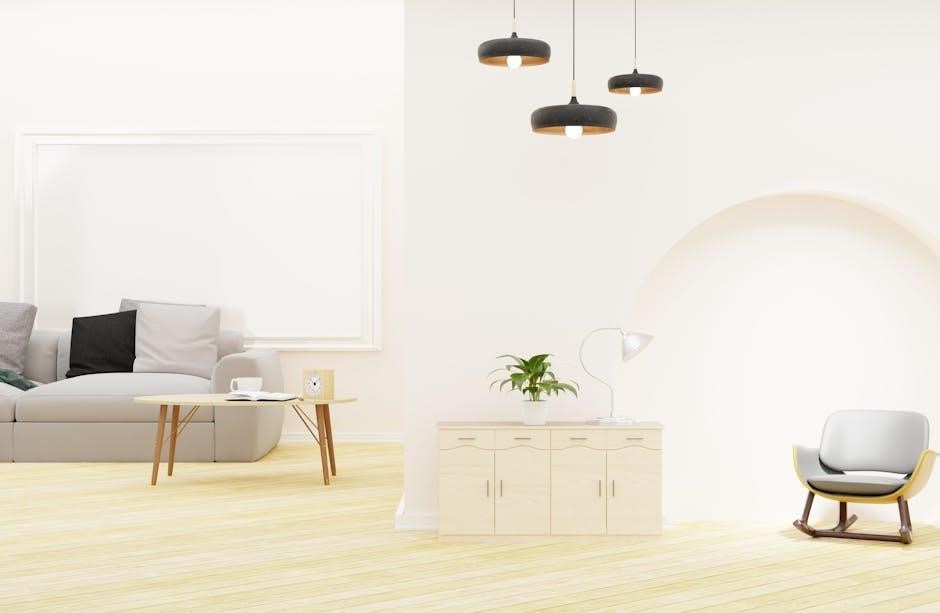
Rug Size and Material Considerations
Rug size and material are intertwined; larger rugs in durable materials suit high-traffic areas, while smaller rugs in softer materials enhance cozy, low-traffic spaces effectively.
6.1 How Material Affects Rug Size Choice
The material of a rug significantly influences its size selection. For instance, natural fibers like wool and jute are often chosen in larger sizes for their durability and texture, making them ideal for high-traffic areas. Synthetic fibers, such as nylon or polyester, are versatile and can work well in both small and large sizes, offering ease of maintenance; The density and pile height of the material also play a role; thicker rugs may require a slightly larger size to ensure they fit comfortably under furniture, while thinner rugs can be more flexible in smaller dimensions. Material choice should align with both lifestyle and interior design goals.
6.2 Pile Height and Its Impact on Rug Size
Pile height plays a crucial role in determining the ideal rug size for a living room. Thicker, high-pile rugs, such as shag or plush styles, often require a slightly larger size to ensure they fit comfortably under furniture and maintain a balanced appearance. Conversely, low-pile rugs, like flat-weave or sisal, can be more flexible in smaller dimensions due to their slim profile. The pile height also influences the room’s aesthetic, as thicker rugs add warmth and texture, while thinner rugs provide a sleek, minimalist look. Considering pile height ensures the rug complements both the room’s decor and functionality, particularly in high-traffic areas where durability and comfort are key.
6.3 Natural vs. Synthetic Fibers and Size
Natural fibers, such as wool and jute, are durable and often used in larger rugs to accommodate high-traffic living rooms, while synthetic fibers like nylon and polyester are versatile and suitable for various sizes. Natural fibers tend to be denser, making them ideal for bigger spaces, whereas synthetic rugs can be more adaptable, fitting smaller or medium-sized rooms seamlessly. The choice between natural and synthetic fibers affects both the rug’s appearance and its functionality, influencing the overall size selection to ensure it meets the room’s needs without compromising style or practicality.
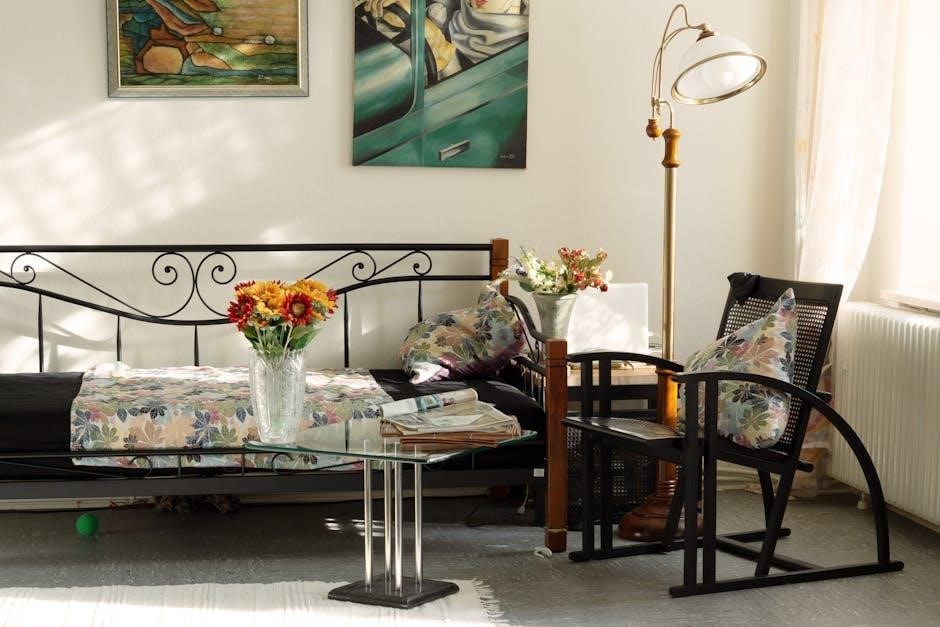
Styling Tips for Choosing the Right Rug Size
Styling with the right rug size enhances harmony, balancing patterns and colors while creating focal points. Layering rugs adds depth, ensuring a visually appealing and cohesive space design.
7.1 Using a Rug to Create a Focal Point
A well-chosen rug can serve as a striking focal point in your living room. By selecting a rug with vibrant colors, bold patterns, or an oversized design, you can instantly draw attention to a specific area. Placing furniture around the rug creates a cohesive look, ensuring the rug remains the centerpiece. Consider the room’s layout and traffic flow to position the rug effectively. Using a rug to create a focal point not only enhances visual appeal but also adds personality to the space, making it more inviting and reflective of your personal style.
7.2 Balancing Patterns and Colors with Rug Size
Balancing patterns and colors with rug size is essential for a harmonious living room design. A rug with bold patterns or vibrant colors can dominate the space, so its size should complement the room’s scale. In smaller rooms, opt for simpler patterns to avoid overwhelming the area, while larger rooms can accommodate more intricate designs. Ensure the rug’s color palette aligns with existing furniture and decor to maintain cohesion. If the room already features patterned upholstery, a solid-colored rug can provide balance. Conversely, a patterned rug can add visual interest to a space with neutral tones. The rug’s size and design should enhance, not overwhelm, the room’s aesthetic.
7.3 Layering Rugs for a Stylish Look
Layering rugs is a stylish way to add depth and texture to your living room. Start with a neutral, large-area rug as the base, then place a smaller, patterned or vibrant rug on top to create visual interest. This technique works well in spacious rooms, allowing you to define different areas within the space. Ensure the rugs complement each other in color and pattern to maintain harmony. For example, a natural fiber rug paired with a bold Moroccan-inspired design can elevate the room’s aesthetic. Experiment with sizes and materials to achieve a look that reflects your personal style while keeping the space cohesive and inviting;
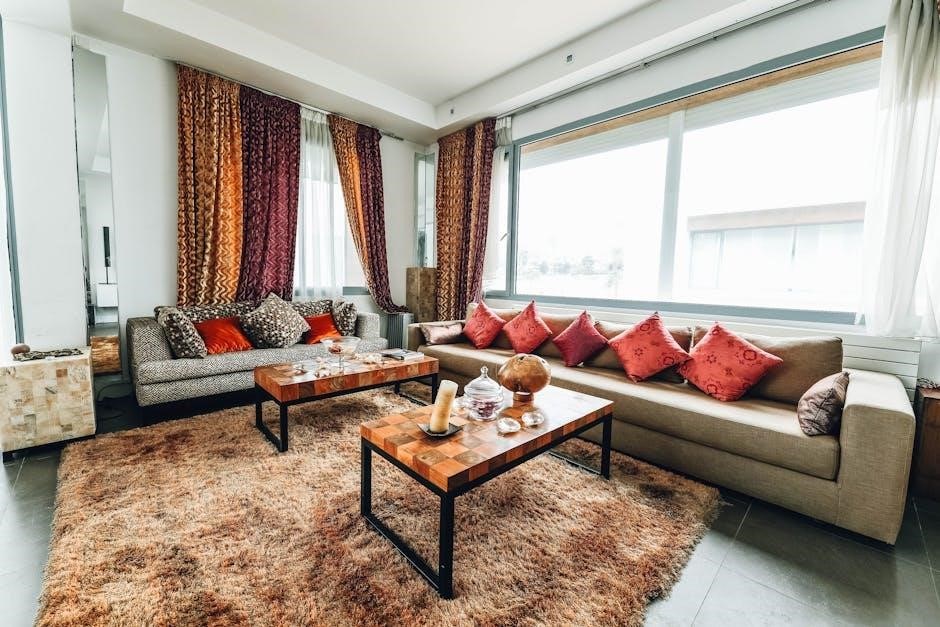
Common Mistakes to Avoid When Selecting a Rug
Common mistakes include buying a rug that’s too small, choosing the wrong shape, or ignoring traffic flow. Ensure proper sizing and alignment to avoid an unbalanced look.
8.1 Buying a Rug That’s Too Small
Buying a rug that’s too small is a common mistake that can disrupt the balance of your living room. A rug that’s too small may leave too much floor exposed, making the space feel disjointed; It can also fail to properly anchor the furniture, creating an uneven aesthetic. To avoid this, measure your room and furniture carefully, ensuring the rug is large enough to fit under all key pieces. Consider the room’s traffic flow and the overall proportions. A rug that’s too small can make the room feel smaller and less cohesive. Always visualize the rug’s placement before purchasing to ensure it complements the space effectively.
8.2 Choosing the Wrong Shape for the Room
Choosing the wrong shape for your living room rug can throw off the entire aesthetic. Rectangular rugs are the most common choice, but they may not always be the best fit. For example, a round rug can complement a circular coffee table or create a cozy atmosphere in a small, oddly shaped room. However, a round rug in a long, narrow room may look out of place. Similarly, a square rug can add symmetry to a square room but may not suit a rectangular space. Always consider the room’s dimensions and furniture layout before deciding on a shape. The wrong shape can make the room feel unbalanced or mismatched, undermining the rug’s intended purpose of harmonizing the space.
8.3 Ignoring the Room’s Traffic Flow
Ignoring the room’s traffic flow when selecting a rug size can lead to a poorly functional space. A rug that is too small or misplaced can disrupt the natural path of movement, creating an obstacle course-like environment. This can make the room feel cramped and less comfortable. Additionally, a rug that doesn’t align with high-traffic areas may fail to protect the flooring in busy zones, leading to wear and tear. It’s essential to consider how people will move through the room and ensure the rug complements this flow. A well-placed rug can enhance the room’s functionality and comfort, while a poorly placed one can hinder it.
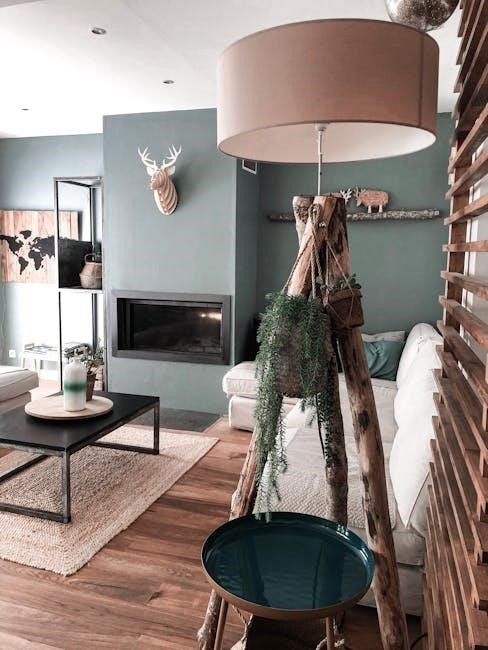
FAQs About Living Room Rug Sizes
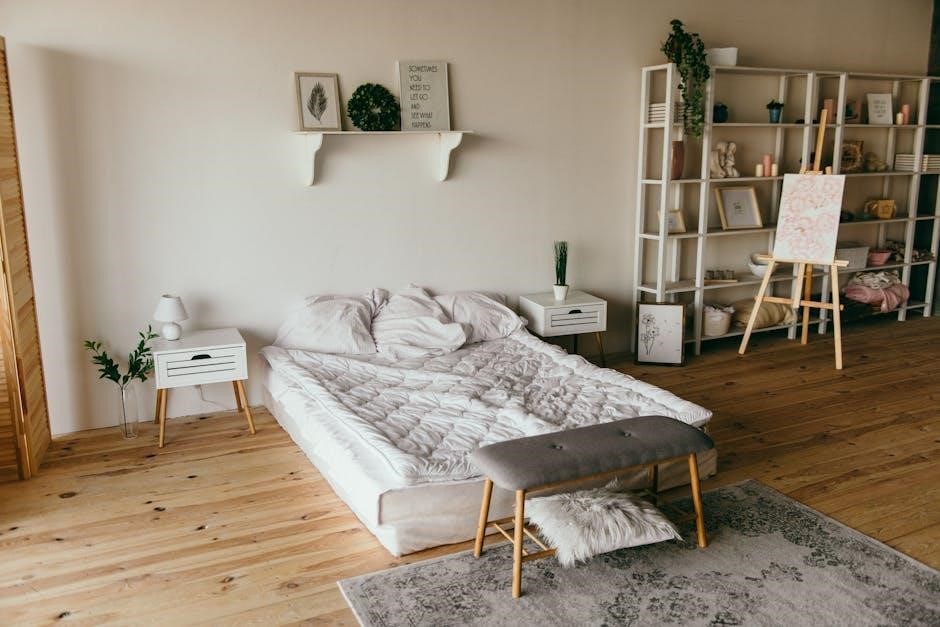
Frequently asked questions about rug sizes for living rooms address common concerns, such as ideal dimensions, shape selection, and material choices, ensuring a perfect fit for any space.
9.1 What’s the Best Rug Size for a Sectional Sofa?
The best rug size for a sectional sofa typically ranges from 8×10 to 9×12 feet, ensuring it fits under the front legs of the sofa and any accompanying chairs or tables. For larger sectionals or spacious rooms, a 9×12-foot rug is ideal, while smaller sectionals may work with an 8×10-foot rug. The rug should extend at least 6-12 inches beyond the sofa on all sides to create a balanced look. Measure the sofa’s dimensions and the room’s layout to determine the perfect fit, ensuring the rug doesn’t overwhelm the space or appear too small. Using tape to outline the rug’s dimensions on the floor can help visualize the size before purchasing.
9.2 Can I Use Multiple Rugs in One Room?
Yes, you can use multiple rugs in one room to enhance the aesthetic and functionality of the space. Layering rugs or placing them in different areas can add texture, warmth, and visual interest. For example, a larger rug can anchor the main seating area, while smaller rugs can define smaller spaces, like a reading nook or entryway. Ensure the rugs complement each other in color, pattern, and size to avoid a cluttered look. Balance is key—pairing a neutral large rug with smaller, bold rugs can create harmony. Measure the spaces carefully and consider the room’s layout to achieve a cohesive design that reflects your personal style.
9.3 How Do I Protect My Hardwood Floors with a Rug?
Using a rug is an excellent way to protect hardwood floors from scratches, dents, and wear. Choose a rug with a non-slip backing or pair it with a rug pad to prevent slipping and ensure stability. The rug’s material should complement the room’s style while offering durability. Natural fibers like wool or jute, or synthetic options like nylon, can be effective. Ensure the rug is large enough to cover high-traffic areas but not so large that it overwhelms the space. Regular cleaning and avoiding excessive moisture will help maintain both the rug and the hardwood floors. Proper placement and maintenance will extend the life of your flooring and enhance the room’s aesthetic.
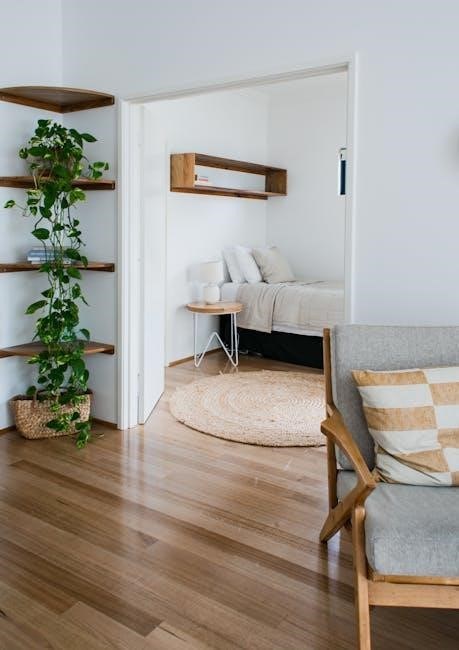
Additional Resources for Rug Size Selection
Explore online guides, size charts, and visual tools to help select the perfect rug. Expert tips and room planners are also available to assist in your decision-making process.
10.1 Rug Size Charts and Guides
Rug size charts and guides are essential tools for selecting the perfect rug. These resources provide detailed measurements and layouts to help visualize how a rug will fit in your space. Many online platforms offer interactive size guides, allowing you to input room dimensions and furniture layouts for personalized recommendations. Printable charts are also available, enabling you to physically compare sizes in your home. Expert tips from interior designers and home decor retailers further enhance these guides, offering insights into proportion, shape, and material considerations. By using these resources, you can make informed decisions and ensure your rug complements your living room’s aesthetic and functionality.
10.2 Online Tools for Visualizing Rug Placement
Online tools for visualizing rug placement are invaluable for planning your space. Many retailers offer “View in Room” features, allowing you to see how a rug fits virtually. Platforms like Room Sketcher and Planner 5D enable you to create floor plans and overlay rugs to scale. These tools help determine the best size and position for your rug. Some apps even let you upload photos of your room for a realistic preview. Additionally, websites like IKEA’s Room Planner provide interactive guides to test rug sizes and shapes. These resources ensure your rug complements your furniture and layout, making the selection process easier and more accurate.
10.3 Expert Tips for Choosing the Perfect Rug
Experts emphasize the importance of measuring accurately and considering furniture placement when selecting a rug. They recommend choosing a rug large enough to fit under all furniture legs for a cohesive look. Material and texture should align with the room’s use; for high-traffic areas, durable materials like wool or synthetic fibers are ideal. Neutral tones and classic patterns offer versatility, while bold colors or statement designs can create a focal point. Layering rugs for texture and depth is another expert-approved technique. Finally, test the rug in the room before committing, using visualization tools or in-home trials to ensure it complements the space perfectly;

